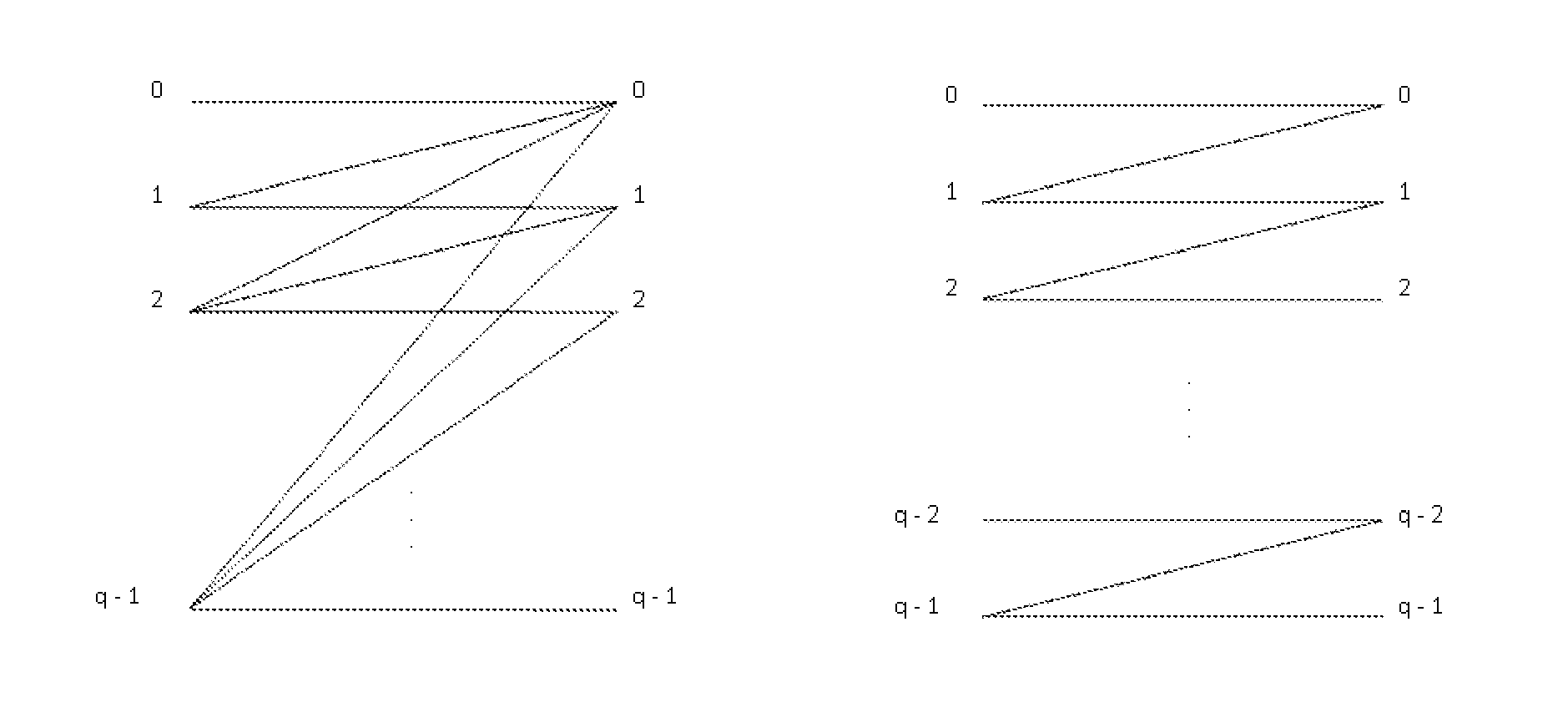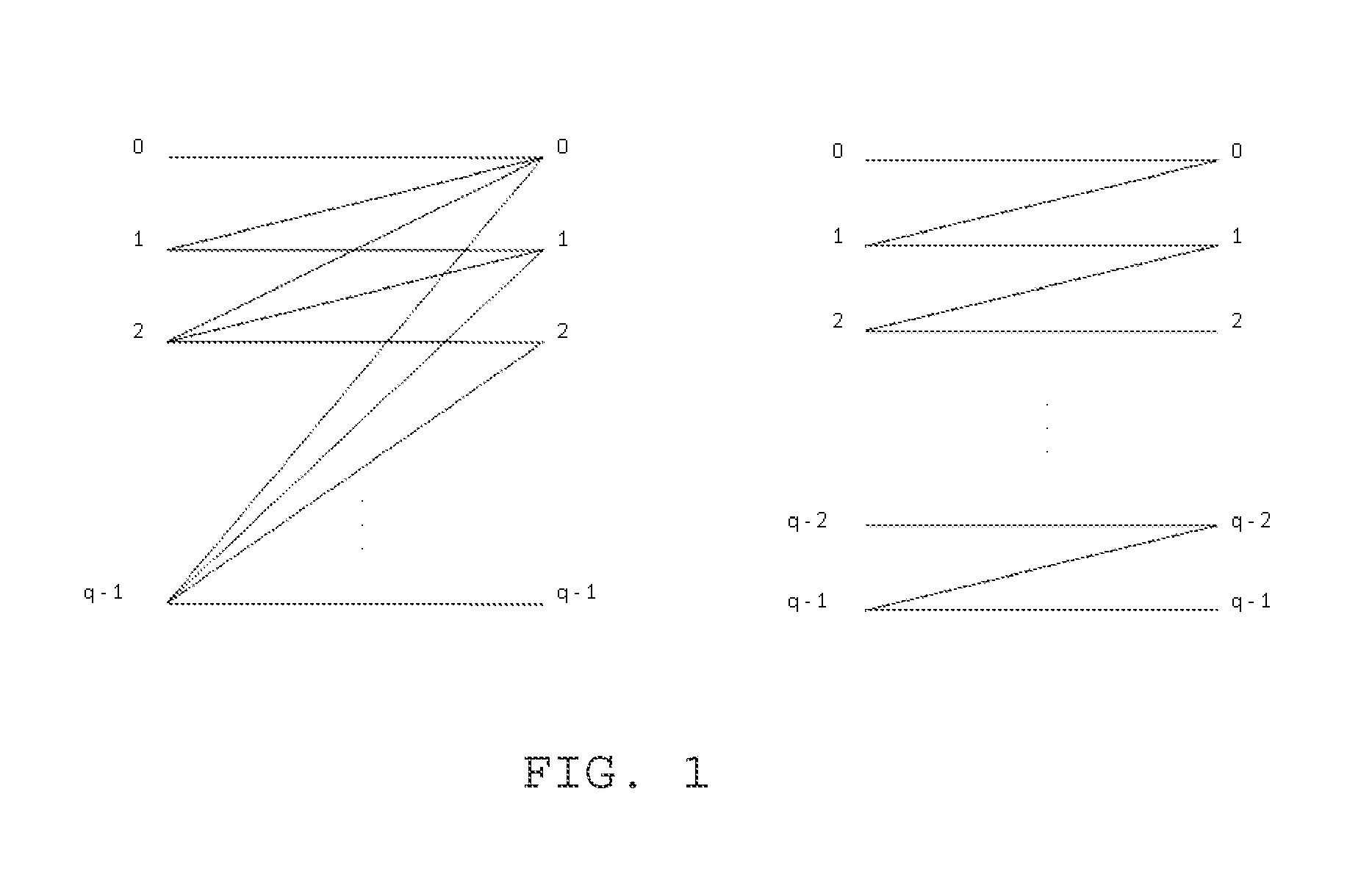System and Method Having Optimal, Systematic q-Ary Codes for Correcting All Asymmetric and Symmetric Errors of Limited Magnitude
a technology of asymmetric and symmetric errors, applied in the field of systems and methods for correcting errors of limited magnitude, can solve problems such as narrow voltage difference between states, asymmetric errors in some vlsi and optical systems, and limited voltage window
- Summary
- Abstract
- Description
- Claims
- Application Information
AI Technical Summary
Benefits of technology
Problems solved by technology
Method used
Image
Examples
example 1
[0033]The word (6,2,8,1) is encoded over Z10, assuming a maximum error level of 2. The minimum number of check digits needed is
r=⌈4log(2+1)log⌈102+1⌉⌉=4.
With notations as above, a=0×33+2×32+2×31+1×30=25 and thus (0,1,2,1) is the representation of a in base 4. Therefore, the encoded codeword is (6,2,8,1,0,3,6,3).
[0034]The following theorem further supports the optimal nature of the above method. Theorem 5: The above construction yields codewords of minimum distance l+1. Proof. Given two distinct information vectors: ν1=(xk-1, xk-2, . . . , x0) and ν2=(yk-1, yk-2, . . . , y0), there are two possibilities: ν1 mod(l+1)≠ν2 mod(l+1) in which case each vector is assigned different check digits and, since the check digits are multiples of (l+1), the distance between the resulting codewords is at least l+1. For the second case, ν1 mod(l+1)=ν2 mod(l+1), ν1 and ν2 are assigned the same check digits. Nevertheless, by distinctness of ν1 and ν2, ∃iε{0, 1, . . . , k−1} such that xi=yi+m(l+1), m≧1....
example 2
[0044]Let the encoded word be as in Example 1 and the channel output be x′=(4,2,7,1,0,3,5,1). Rounding the check symbols which are not multiple of three upwards to the nearest multiple of 3, we get (0,3,6,3). As in Steps 2 and 3 of the algorithm, we compute a=01214=25, and y=(0,2,2,1). Thus, the correct information symbols are (6,2,8,1).
[0045]The following theorem validates the above decoding method. Theorem 6: Let x be a codeword encoded using the encoding algorithm given in above, and let x′ be the l-asymmetric channel output. Then, the above l-AEC decoding method successfully recovers x. Proof Let x=(xk-1, xk-2, . . . , x0, cr-1, cr-2, . . . , c0), then, by the channel properties, x′=(xk-1′, xk-2′, . . . , x0, cr-1′, cr-2′, . . . , c0′) is such that xi−l≦xi′≦xi and ci−l≦ci′≦ci. Moreover, the encoding algorithm yields check symbols that are multiples of l+1, i.e. ci′ lies between two successive multiples of l+1. Therefore, the first step of the decoding algorithm successfully reco...
example 3
[0065]We encode the word (5,3,7,0) over Z10, assuming a maximum symmetric error level of 1. The number of check digits needed is
r=⌈4log(2×1+1)log⌈102×1+1⌉⌉=4.
Then, (y3, y2, y1, y0)=(2,0,1,0) and a=2×33+0×32+1×31+0×30=57. Now, a=57 in radix
⌈q2l+1⌉=⌈104⌉=4
representation is (0,3,2,1) and so, the check is (0,9,6,3). Therefore, the encoded codeword is (5,3,7,0,0,9,6,3).
l-SEC Decoding Algorithm
[0066]Input: The channel output: x′=(xk-1′, xk-2′, . . . , x0′, cr-1′, cr-2′, . . . , c0′)
[0067]Output: The recovered codeword: (xk-1, xk-2, . . . , x0, cr-1, cr-2, . . . , c0)
[0068]A method of the present invention for l-SEC decoding may then include the steps of:[0069]1. Recovering the check symbols, (cr-1, cr-2, . . . , c0), by rounding each received check symbol which is not a multiple of 2l+1 either upwards or downwards to the nearest multiple of 2l+1, whichever is closer.[0070]2. Computing a, the value of
(cr-12l+1,cr-22l+1,…,c02l+1)
as a vector over
Z⌈q2l+1⌉:a=(cr-12l+1)⌈q2l+1⌉r-1+(cr-22l+1)⌈q2l...
PUM
 Login to View More
Login to View More Abstract
Description
Claims
Application Information
 Login to View More
Login to View More - R&D
- Intellectual Property
- Life Sciences
- Materials
- Tech Scout
- Unparalleled Data Quality
- Higher Quality Content
- 60% Fewer Hallucinations
Browse by: Latest US Patents, China's latest patents, Technical Efficacy Thesaurus, Application Domain, Technology Topic, Popular Technical Reports.
© 2025 PatSnap. All rights reserved.Legal|Privacy policy|Modern Slavery Act Transparency Statement|Sitemap|About US| Contact US: help@patsnap.com



